11 Insurance Workflows You Can Automate in 2025 By Using Joget
Date
Jul 07, 25
Reading Time
10 Minutes
Category
Low-Code/No-Code Development
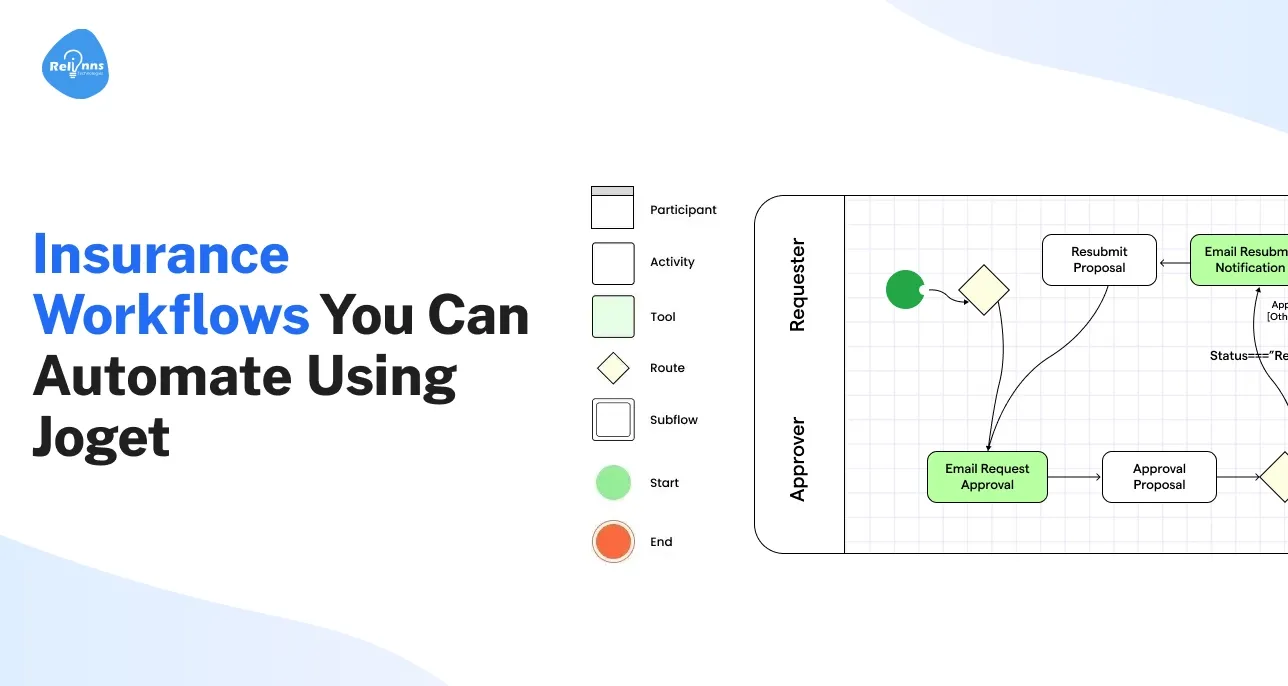
Insurance companies today handle massive volumes of data and processes, often with legacy, manual methods. This slows everything down and leads to errors that frustrate customers.
It’s no surprise insurers are turning to automation and digital platforms to stay efficient and competitive.
Joget, a no-code/low-code application platform, is emerging as a game-changer in this space. It empowers insurance teams to automate workflows without heavy coding, speeding up work and reducing mistakes.
The advantages of automation in insurance workflows are clear: faster service, lower costs, and greater accuracy.
The good news is that low-code platforms like Joget make it easier than ever to streamline operations.
Let’s break down 11 insurance workflows you can automate in 2025 by using Joget for maximum impact.
Which insurance workflows can you automate by using Joget?
Automation is transforming the insurance workflow industry by replacing manual, error-prone tasks with intelligent, low-code workflows.
Using Joget, insurers can streamline operations, boost efficiency, and deliver faster, more reliable service across these 11 key insurance processes.
1. Claims processing
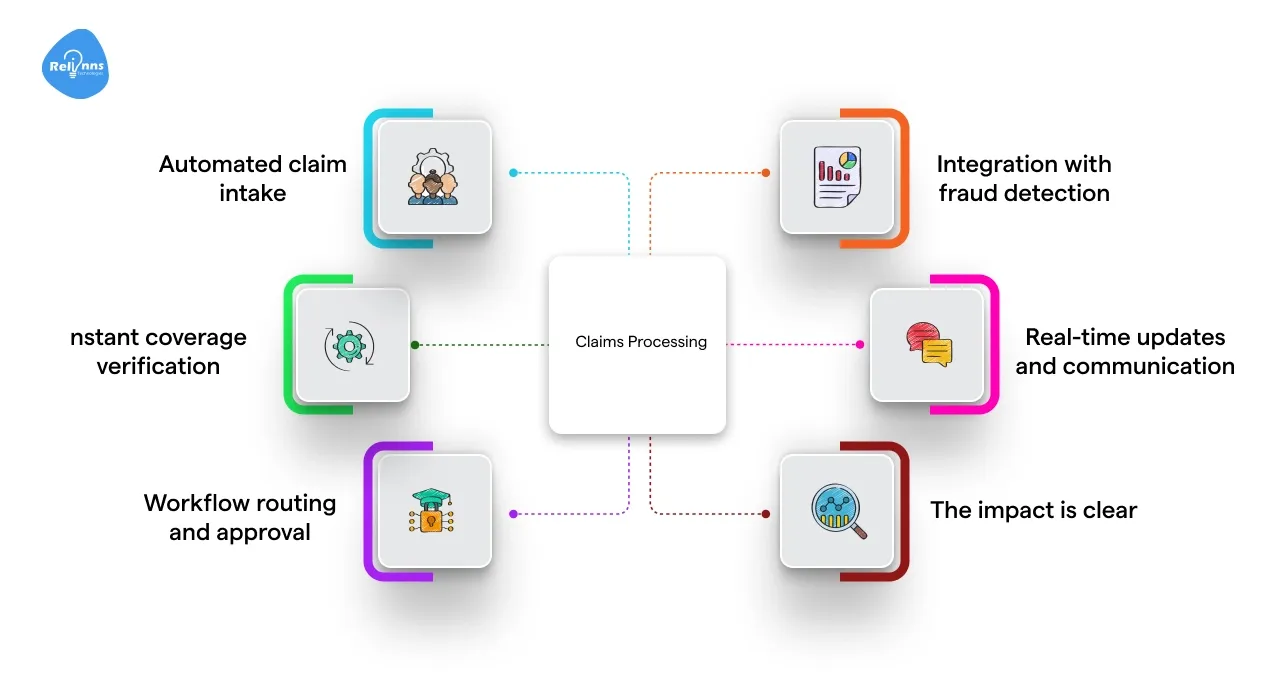
Claims processing is the cornerstone of insurance workflow operations and one of the most important workflows to automate.
Handling claims manually often means mountains of paperwork, long approval chains, and frustrated customers waiting weeks for payouts. By automating the claims process, insurers can dramatically accelerate this workflow while cutting errors.
Here’s how automation transforms insurance workflow claims processing
- Automated claim intake: Instead of paper forms, customers submit claims through digital forms or mobile apps. The system automatically captures all required data (policy number, incident details, evidence photos) into a centralized platform.
- Instant coverage verification: An automated workflow checks the claimant’s policy in seconds to verify coverage and policy limits. This step, which might require hours of human cross-checking, happens in real time.
- Workflow routing and approval: The claim is automatically routed to the appropriate adjuster or team based on its type and severity. Minor claims can even be auto-approved using preset rules. Higher-value or complex claims get flagged for manual review, but all documentation is already organized for the adjuster.
- Integration with fraud detection: The system cross-checks claims with fraud detection algorithms. Suspicious patterns are automatically flagged for investigation. Legitimate claims proceed without delay, while potential fraud gets extra scrutiny.
- Real-time updates and communication: Throughout the process, the workflow sends automated updates to the customer e.g., “Your claim is received,” “Your claim is approved,” “Payment is issued”.
This end-to-end automation greatly reduces processing times. According to McKinsey, automation can reduce claims processing time by up to 50%, enabling insurers to settle claims in days rather than weeks.
The impact is clear: claims automation leads to quicker payouts, fewer errors, and a better experience for policyholders when they need it most.
2. Policy underwriting
Underwriting is a critical and complex insurance workflow perfect for automation.
Traditionally, underwriters spend days (or weeks) collecting data, assessing risk factors, and deciding whether to approve a policy and at what price. This manual approach can be slow and inconsistent.
Automating underwriting speeds up the process and makes results more consistent by letting algorithms handle the heavy lifting.
Here’s how automated underwriting works in practice
- Streamlined data collection: Instead of manually gathering applicant information from multiple sources, an automated system pulls data from online applications, databases, and even third-party services instantly.
- Rule-based risk assessment: Joget allows insurers to create rule engines that automatically evaluate risk. It only flags exceptions (e.g., high-risk profiles) for human review.
- AI-driven analysis: Advanced systems leverage AI and machine learning to analyze historical data and detect patterns. This reduces subjectivity and human bias in underwriting decisions.
- Instant quotes and decisions: Because the data crunching is automated, insurers can provide quotes to customers in real time. Many routine policies can be approved and issued almost immediately once the applicant’s data is processed.
- Audit trail and compliance: Every step in the underwriting decision is recorded by the workflow. This makes it easy to demonstrate compliance with underwriting guidelines and regulatory standards, since you have a clear log of how each decision was reached.
The result is a faster, more consistent underwriting process. Policies get issued faster, and customers don’t have to wait endlessly for a decision. Automating underwriting also improves accuracy decisions are based on data and set rules, not just human judgment calls.
This consistency means fewer errors in assessing risk. Ultimately, automation lets underwriters focus on complex cases and exceptions, while straight-through processing handles the rest.
The outcome is a win-win: lower underwriting costs for the insurer and a smoother, quicker experience for new customers seeking coverage.
Suggested Reading: Joget’s Role in Automating SMB Workflows Efficiently
3. Customer onboarding
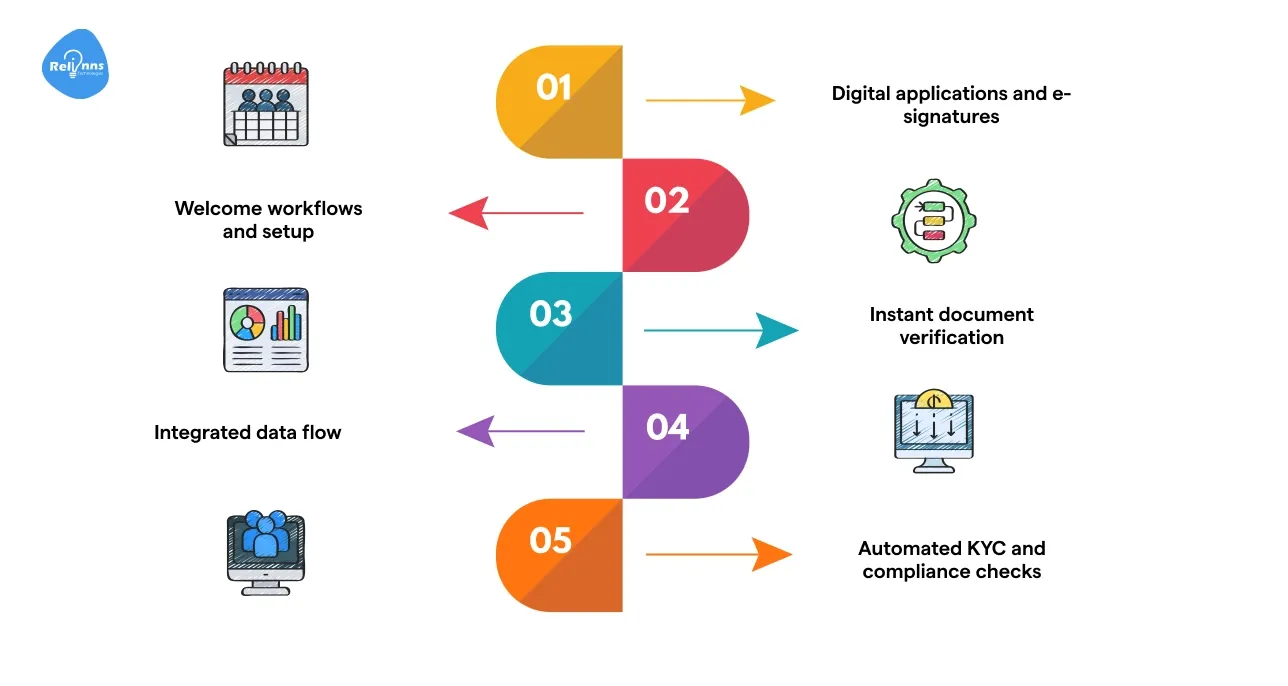
First impressions matter in insurance. The customer onboarding process from initial application to issuing the policy sets the tone for the customer’s relationship with the company.
If onboarding is slow or full of paperwork, customers may drop off or feel frustrated. That’s why automating this workflow is so beneficial.
Automated customer onboarding makes it easy for new clients to sign up, submit documents, and get their policy issued without delay.
How insurance workflow companies can automate onboarding and enrollment?
- Digital applications and e-signatures: Rather than printing and mailing forms, customers can apply through an online portal or mobile app. No more chasing paperwork everything is captured electronically.
- Instant document verification: When customers upload IDs or documents, automated tools using OCR and AI can verify them. The platform checks that documents are legible, authentic, and meet requirements, flagging any issues automatically.
- Automated KYC and compliance checks: Know-Your-Customer data and anti-fraud checks can run in the background. The workflow automatically cross-references customer info against watchlists or databases to ensure compliance with regulations.
- Welcome workflows and setup: Once approved, the system automatically creates the customer’s account in all relevant systems. It can also trigger a personalized welcome email or SMS with policy details, next steps, and contacts for support.
- Integrated data flow: All departments—underwriting, policy admin, billing—get the data they need from the central workflow. There’s no need to re-enter information in multiple systems.
By automating onboarding, insurers drastically reduce the time and effort to bring a new customer on board. Manual onboarding could take days of back-and-forth; automation cuts it to minutes.
The bottom line is a smoother start for the customer and a more efficient process for the insurer. Clients perceive the company as easy to do business with, laying the groundwork for a long and positive relationship.
4. Policy issuance & new policy setup
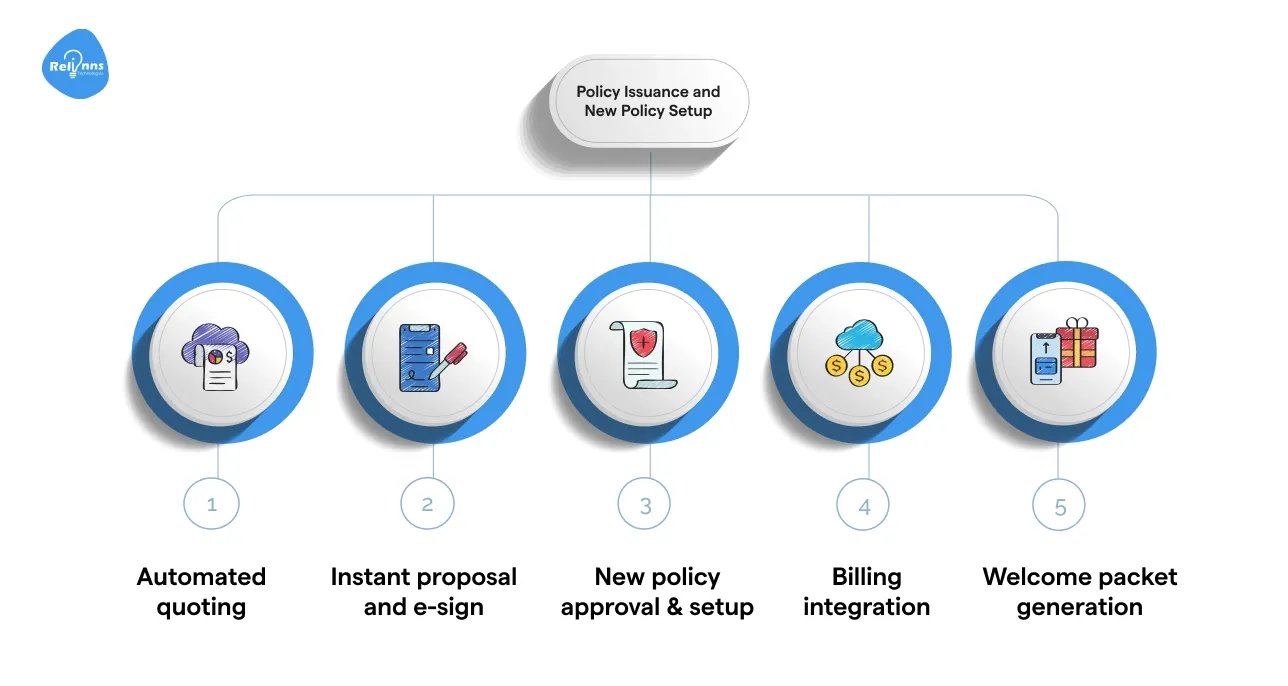
Converting an interested prospect into an active policyholder involves multiple steps that are ripe for automation.
Policy issuance (also called new business processing) includes generating a quote, getting it approved, issuing the policy documents, and setting up the customer’s account.
By automating policy issuance, insurers can close sales faster, improve accuracy, and impress new customers with instant service.
Here’s what automating the policy issuance workflow looks like:
- Automated quoting: Sales agents or customers input basic info (coverage needs, personal details) into a digital form. The system immediately calculates a quote using preset rate tables and rules.
- Instant proposal and e-sign: The applicant can receive a digital policy proposal or insurance workflow contract right away. Automation tools generate customized policy documents on the fly. Customers then review and sign electronically.
- New policy approval & setup: Once signed, the workflow automatically routes the policy for final checks/approval if needed. The new policy is then created in the policy management system without anyone re-keying data.
- Billing integration: The moment the policy is issued, the billing system is notified. If the customer chose an installment plan, the system sets up the payment schedule and can even charge the first premium automatically as per the configured workflow.
- Welcome packet generation: Automated workflows can generate a welcome packet or policy kit in PDF and email it to the customer. Alternatively, the customer gets access to an online portal where they can download their policy and related documents immediately.
By eliminating manual steps, insurers can issue policies much faster.
In other words, automation not only saves time but also helps increase conversion rates for new policies. Plus, with data flowing automatically from quote to issue to billing, there are fewer clerical errors.
All of this leads to a seamless experience for the customer they go from getting a quote to being insured without hassle.
5. Policy renewals and endorsements

Retaining customers is just as important as acquiring new ones.
Automating policy renewals when an insurance workflow policy is up for renewal at the end of its term are a prime opportunity to use automation to increase efficiency and keep customers happy.
Similarly, policy endorsements involve repetitive processes that can be streamlined.
How can an automated renewal and endorsement process work?
- Proactive reminders: The system tracks policy end dates and automatically sends renewal reminders to customers before their policy expires. This gentle, automated nudge improves renewal rates by keeping customers informed.
- One-click renewals: For many policies, if nothing significant has changed, the easiest path is auto-renewal. An automated workflow can present the customer with their current coverage and premium for the next term, and they simply click to accept and renew.
- Automated rate adjustments: If premiums need to be adjusted (due to inflation, claims history, etc.), the system can calculate the new premium at renewal using predefined rules.
- Streamlined policy changes: If the customer needs changes, they can submit a request through an online form. The workflow automatically updates the policy with the requested endorsements once approved, and regenerates the policy documents.
- Renewal confirmation and documentation: Once renewed, the system sends the customer updated policy documents or an endorsement schedule reflecting the changes.
By automating these steps, insurers remove the friction from the renewal process.
This not only saves time but also boosts customer satisfaction: clients appreciate a hassle-free renewal with no paperwork.
Ultimately, automating renewals protects revenue (by retaining more customers) and ensures that policyholders stay covered without service interruption.
6. Billing and premium payments
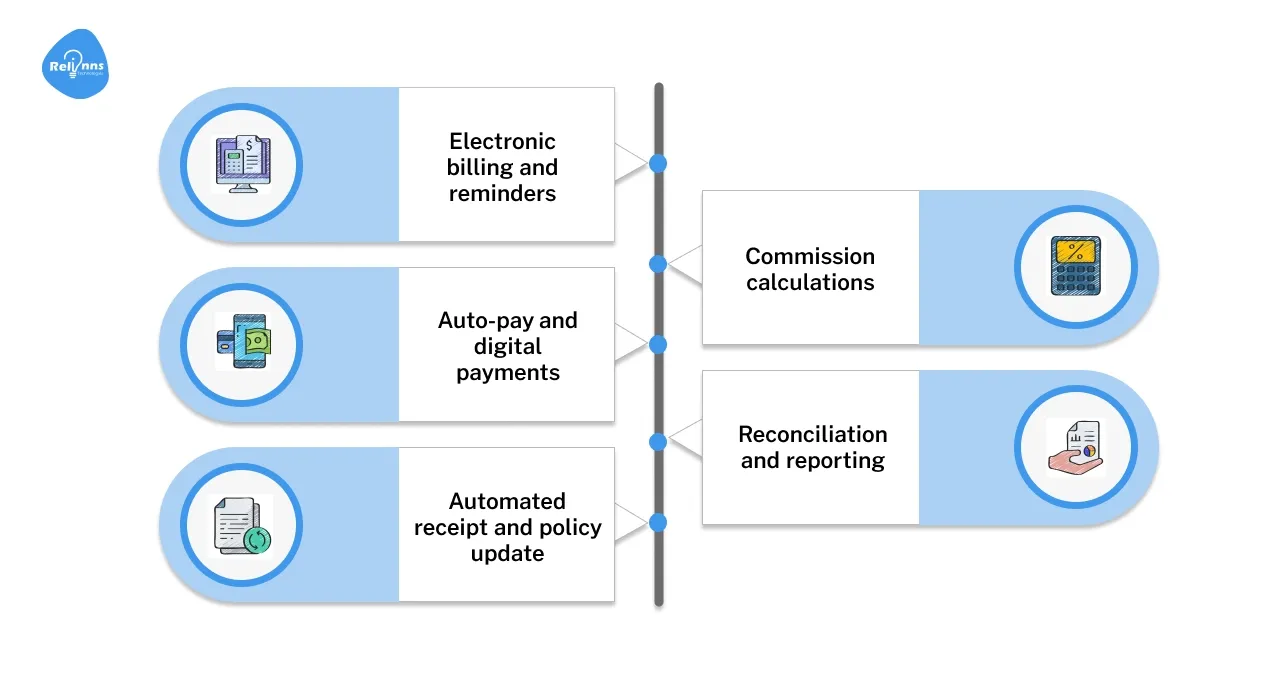
Handling premium payments and billing schedules is a routine but crucial part of the insurance workflow business.
Mistakes in billing can upset customers and even lead to coverage lapses if payments are missed.
Traditionally, billing clerks would send invoices, process checks or card payments, and update accounts a process prone to delays and errors.
Automating the billing workflow makes revenue collection more reliable and gives customers a smoother payment experience.
Here’s how automated insurance workflow billing works?
- Electronic billing and reminders: Instead of mailing paper bills, the system generates electronic invoices for premiums due and emails them to customers (or posts them to their online accounts).
- Auto-pay and digital payments: Customers can opt into automatic payments. With autopay, the platform will automatically charge the customer’s saved credit card or bank account on the due date each month/quarter.
- Automated receipt and policy update: Once payment is received, the workflow issues a digital receipt or confirmation to the customer. The policy status is automatically updated to paid/current.
- Commission calculations: For insurers working with agents or brokers, the billing system can automatically calculate commissions to be paid out from each premium.
- Reconciliation and reporting: Automation helps reconcile payments with bank statements. The system can match incoming payments to invoices, flag any discrepancies, and even generate accounting reports.
By automating premium billing, insurers see fewer late payments and defaults. One reason is the timely, consistent reminders and the ease of one-click payments which removes barriers for the customer to pay on time.
Overall, billing automation means insurers get paid on time with minimal fuss, and customers enjoy a convenient, modern payment process for their insurance workflow.
7. Compliance and regulatory reporting
The insurance industry is one of the most heavily regulated, with strict guidelines governing everything from data privacy to financial reporting and claims handling.
Meeting these compliance requirements often requires compiling reports and documentation that can be extremely time-consuming if done manually.
Automating compliance workflows enables insurers to efficiently and accurately manage their regulatory duties.
Here’s how automation supports insurance workflow compliance and reporting?
- Scheduled regulatory reports: The system can be configured to automatically generate required reports (daily, monthly, quarterly, as needed).
- Real-time compliance checks: As processes run (like underwriting or claims), automated rules check each step against compliance criteria.
- Regulatory updates integration: When regulations change, an automated system can be updated centrally and then ensure all workflows adhere to the new rules.
- Audit trail and documentation: Every automated action is logged with a timestamp and user info. This creates a detailed audit trail.
- Automated alerts and reminders: Compliance officers can receive automatic alerts for key events. The workflow ensures nothing falls through the cracks by notifying the right people at the right time.
Importantly, automation reduces the risk of non-compliance. Companies are less likely to miss a required filing or step, since the system is always on duty.
This helps avoid penalties and fines that can result from compliance lapses. In short, automating compliance gives insurers peace of mind.
They know that routine regulatory tasks are handled consistently and correctly, allowing them to focus on serving customers and growing the business without running afoul of the rules.
Suggested Reading: Joget for Financial Services:Automation That Deliver Results
8. Document management and paperwork digitization

Insurance companies deal with an avalanche of documents: policy applications, claim forms, supporting evidence, contracts, regulatory forms, and more.
Traditionally, much of this existed on paper filed in cabinets or scanned into disorganized folders.
Automating document management and going paperless is a workflow overhaul that can save time, space, and reduce errors.
Here’s how an automated document management workflow benefits insurers?
- Digital intake of documents: Whether it’s a customer uploading a photo of a damaged car for a claim, or an agent submitting a signed contract, all documents enter the system digitally.
- Categorization and routing: The moment a document is received, automation classifies it (as a claim evidence, KYC document, policy form, etc.). It’s then automatically routed to the relevant workflow.
- Centralized repository: All documents are stored in a secure central repository or database. Team members with proper permissions can retrieve any file within seconds by searching policy number, customer name, or other metadata.
- Version control and auditing: When documents like policy wordings or contracts get updated, automation maintains version control. Everyone accesses the latest template, and any changes are tracked.
- Retention and disposal: Insurance workflow regulations often dictate how long documents must be retained. Automated workflows can handle this by flagging documents for archival or deletion once they’ve passed their retention period.
The shift to automated, digital document management has significant payoffs.
Automation virtually eliminates lost documents and frees up space (and budget). Moreover, the reduction in paper use aligns with sustainability goals and often saves money on printing and mailing.
Importantly, having documents organized and accessible means better service for customers. Overall, automating document workflows makes an insurance company more agile, responsive, and secure in its information handling.
9. Fraud detection and risk monitoring
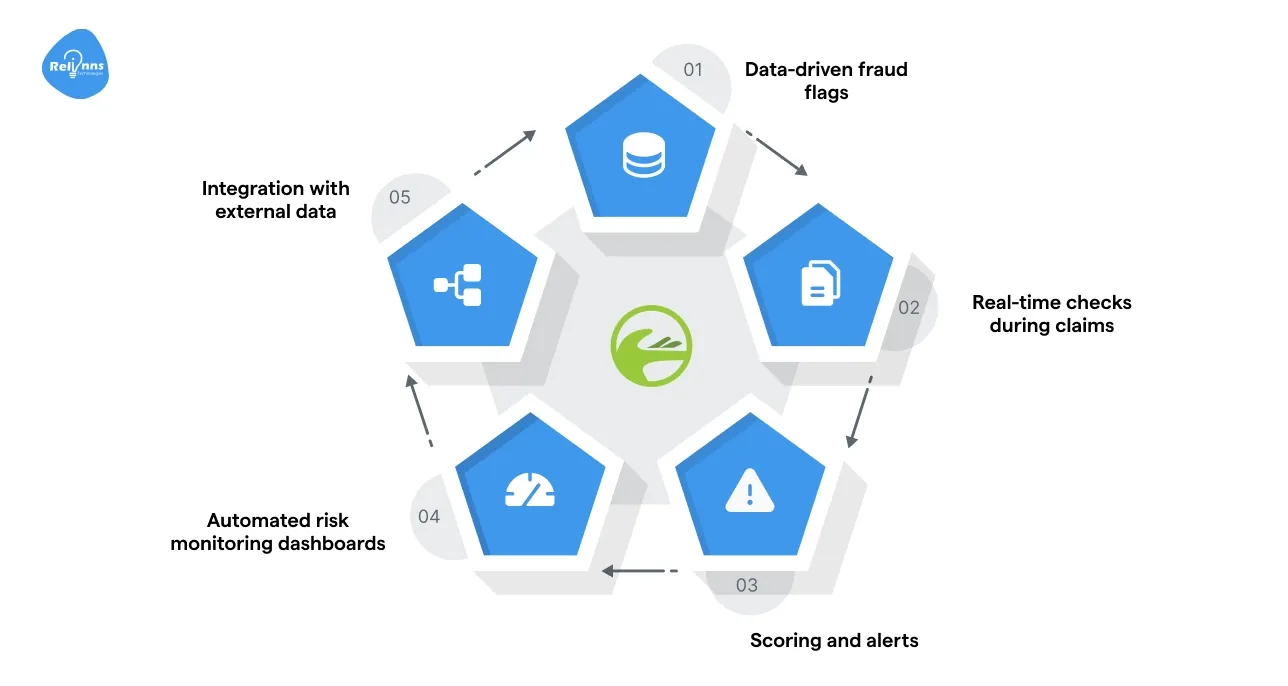
Insurance fraud is a persistent challenge that costs the industry billions of dollars each year.
Traditionally, fraud detection relied on manual audits or tips, often catching problems only after a claim had been paid.
But with modern tools, insurers can automate fraud detection as an integral part of their workflows and continuously monitor risk in their portfolio.
Here’s how automation enhances fraud detection and risk management:
- Data-driven fraud flags: Automated systems analyze claims data for patterns that suggest fraud. Machine learning models are especially good at spotting subtle patterns across large datasets far more than a human could manage.
- Real-time checks during claims: When a new claim comes in, the workflow automatically runs fraud-detection checks on the spot. It might cross-reference the claim with databases of known fraudsters or compare details against past claims.
- Scoring and alerts: Each claim (or even each policy application) can be given a fraud risk score by the automated system. If the score is low, the claim proceeds normally.
- Automated risk monitoring dashboards: Beyond individual claims, automation helps monitor overall risk exposure. Dashboards fed by real-time data can show, for example, if a certain area is experiencing a spike in a type of claim.
- Integration with external data: Automated workflows can pull in external data like social media, credit reports, or IoT data (telematics from cars, smart home sensor data) to cross-verify claims and detect anomalies.
By using automation and AI for fraud detection, insurers are catching fraudulent claims much faster up to 50% faster, according to industry metrics.
In summary, automating fraud detection makes an insurer both nimble and tough in responding to risk patterns, and tough on those who attempt to game the system.
It builds a more secure and trustworthy operation in the eyes of regulators and customers alike.
10. Agent and broker management

For insurers that sell through agents or brokers, managing those relationships and processes is a significant workflow of its own.
Traditional agent management can involve heaps of paperwork licensing, appointments, commission statements, performance tracking, and communication of new product information.
By introducing automation into agent and broker management, insurance workflow companies can strengthen their distribution network, reduce administrative overhead, and ensure agents have what they need to sell effectively.
Here are ways automating agent management can make a difference
- Onboarding new agents: Bringing a new agent on board involves verifying licenses, collecting contracts, and setting them up in multiple systems (sales, commission, portal access).
- Commission tracking and payouts: As agents sell policies, an automated system calculates their commissions in real time based on the commission structure.
- Performance monitoring: Automation provides transparency into agent performance. Dashboards can display sales figures, conversion rates, persistency (renewal rates), etc., updated continuously.
- Communication and training: Automated workflows can send out updates or required training to agents. This ensures a consistent flow of information across a large agent network.
- Compliance and licensing renewals: The platform can keep track of each agent’s licensing status and renewal dates (since agents must maintain licenses to sell).
By automating these facets of agent and broker management, insurers save tremendous administrative effort.
All of this contributes to stronger agent engagement and loyalty. In an industry where independent agents often choose which companies to place business with, providing an easy, automated experience is a competitive advantage.
Thus, automating agent workflows helps insurers grow and manage their distribution force more effectively, translating to more sales and better coverage for customers in the long run.
11. Customer service and support
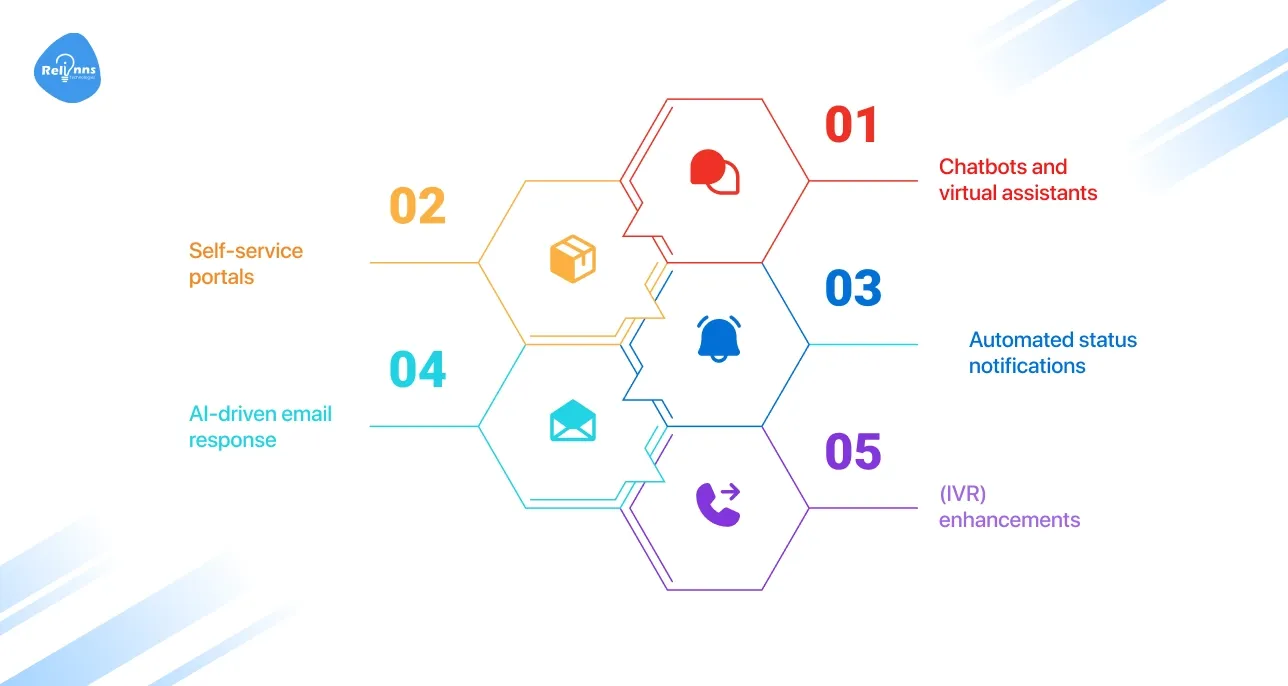
In the insurance workflow industry, customer service can make or break client relationships.
Policyholders frequently have questions about coverage, claims status, billing, and more. Traditional customer support (phones ringing in a call center) can be costly and may keep customers waiting.
By automating portions of customer service, insurers can provide faster, 24/7 support while reducing the load on human agents.
Here’s how automation improves insurance customer support
- Chatbots and virtual assistants: Insurance companies can deploy AI-powered chatbots (on their website or messaging apps) that answer common questions instantly.
- Self-service portals: Automation enables robust online self-service for customers. Through a secure portal or mobile app, customers can do things all without calling in.
- Automated status notifications: Keeping customers informed is key to satisfaction. Workflows can automatically send notifications for important events.
- AI-driven email response: When customers email support, AI can categorize and even draft responses for simpler queries.
- Interactive voice response (IVR) enhancements: Even traditional phone support can be partially automated. Modern IVR systems, powered by AI, can understand spoken requests.
By implementing these solutions, insurers have seen customer satisfaction surge.
From an operational view, automated customer service can lower support costs. Chatbots and self-service portals can handle thousands of inquiries concurrently, something not possible with purely human staff.
In summary, automating customer support allows insurance providers to deliver prompt, around-the-clock service.
Happy customers are more likely to stay loyal and even purchase additional products, so this workflow automation directly contributes to retention and growth.
How do you get started with automating insurance workflows using Joget?
Insurance companies worldwide are realizing that the future is automated.
These 11 workflows outlined above show how nearly every aspect of an insurance business from the first customer interaction to the final compliance check can be improved by the right automation tools.
Adopting a platform like Joget makes this transformation accessible, even for insurers with limited IT resources, thanks to its low-code approach.
Relinns, as a leading expert in Joget implementation, has helped insurers automate these exact workflows with impressive results. Modernizing your processes may sound like a significant step, but with the proper guidance, it can be remarkably smooth.
If you’re ready to automate your insurance workflows and reap the benefits faster service, lower costs, happier customers now is the time to act.
Why you should use Relinns:
- Proven track record in delivering Joget-based automation solutions tailored to the insurance industry.
- Deep expertise in low-code implementation with fast turnaround and minimal IT dependency.
- Custom workflow development for claims, underwriting, KYC, billing, and more.
- Scalable architecture ready for compliance, multi-region deployments, and 24/7 operations.
- End-to-end support: from consulting and design to launch, optimization, and team training.
Reach out to Relinns today to explore how Joget-powered automation can streamline your operations. It’s time to leave tedious manual work behind and focus on innovation and customer satisfaction.
Choose automation, choose efficiency, and watch your insurance enterprise thrive in the modern era. Let Relinns help you get started on this journey to a smarter, automated insurance workflow system.
Frequently Asked Questions (FAQs)
What is workflow in insurance?
A workflow in insurance is the step-by-step process that manages tasks like policy creation, claims handling, approvals, and customer communication, ensuring operations run smoothly and efficiently from start to finish.
What is automation in insurance?
Automation in insurance uses technology to handle routine tasks like claims processing, policy updates, and customer communication, reducing manual effort, cutting errors, and improving speed, accuracy, and customer experience.
What are the benefits of automating insurance workflows for small agencies?
Even small agencies can boost efficiency, reduce errors, and compete with larger firms by automating repetitive tasks like claims intake, KYC, and policy renewals using low-code platforms.
How does Joget compare with other insurance workflow automation platforms?
Joget stands out for its drag-and-drop UI, rapid deployment, and lower learning curve—making it more accessible than complex platforms like Pega or Appian.
Can insurance automation improve customer retention?
Yes, automation leads to faster service, proactive communication, and fewer mistakes—key factors that improve customer satisfaction and long-term loyalty.
Is Joget suitable for compliance-intensive insurance markets, such as the US or EU?
Absolutely. Joget offers real-time validation, audit trails, and flexible rule engines that help insurers meet regional compliance standards with ease.
How quickly can we automate one insurance workflow with Joget?
With prebuilt templates and Relinns’s support, insurers can automate a workflow like claims intake or onboarding in as little as 2–3 weeks.
Can Joget integrate with legacy insurance software systems?
Yes, Joget supports REST/SOAP APIs and database connectors, making it easy to bridge modern workflows with existing legacy platforms like Guidewire or core policy systems.
How do you automate workflows?
You automate workflows by mapping tasks, setting rules, and using software tools to handle repetitive steps like approvals, notifications, and data entry—saving time and reducing errors.



